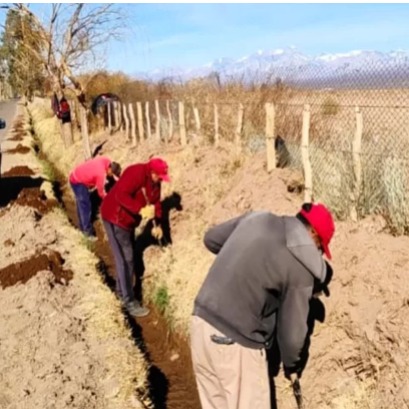
San Juan | In the municipality of Calingasta they advance with a afforestation plan to improve the landscape and mitigate the wind with more than 350 willows planted in Barreal
The municipality of Calingasta started with an important afforestation operation that seeks to improve both the landscape and the environment. In this context, they planted about 350 wills in different points of Barreal that will also serve with barrier to contain the zonda wind and strengthen the ground to contain the growing.
Diego Ossa, Secretary of Works, Services and Environment, said that Forestation will continue in other localities of the department. In addition, he asked the neighbors to take care of the new specimens to ensure their growth. A couple of week was carried out by this afforestation operation at different key points of Barreal with about 350 wills. The largest plantation was made on Libertad Street where, along 1.5 kilometers, 161 stakes of this specimen were placed, while another 25 were placed in the post of the rivers, and the rest was distributed between Echeverría street, In the Balcón de Ansilta neighborhood, and the South Costanera of the Los Patos River. In Barreal we have planted between 300 and 350 and also a significant amount of poplars. While in Tamboías we have placed 80 willow stakes on the Los Pioneros bridge where we are building the new spa. And we will continue with the afforestation in other locations so that Calingasta recovers the green of before, said Ossa. The official asked for the collaboration of the neighbors to take care of these stakes of vandalism so that they grow healthy and thus throw the first outbreaks in about 3 more months. He said that in about 5 years, if everything remains well, these trees will begin to shade. ?The main care that these specimens must have is that they do not break them because they were all planted in areas with irrigation by ditch so they will not miss water,? said the Secretary of Works. Wet Its leaves can be oval, serrated or elongated according to the species, also showing a large range of colors (between green and bluish). Today, it is common to take advantage of its wood for construction and cultivate them as an ornamental tree. Diego Ossa said that this species was chosen to forest barriers for the defenses offered before climatic adversities. ?Once grown up, its branch is intertwined and serves as a barrier to contain the winds, while their roots that form a kind of sponge, serve to strengthen the ground and contain the growing,? the official explained.
IT MAY INTEREST YOU
 Trees tell stories: the fascinating science of dendrochronology
Trees tell stories: the fascinating science of dendrochronology
A fascinating science, dendrochronology transforms tree rings into a vast archive of climate history, revealing connections between the past and the future. With each ring, a new story of resilience and adaptation comes to life.
 Black River | Government and institutions promote a balanced development model between production and the environment in Valles Irrigados
Black River | Government and institutions promote a balanced development model between production and the environment in Valles Irrigados
Within the framework of the impulse that the Provincial Government has been giving to forestry policy, a joint tour was carried out between the Forestry Directorate of the Ministry of Economic and Productive Development, the Provincial Department of Water (DPA), the National Institute of Agricultural Technology (INTA) and the consulting firm Lygnum.
 Botanists discover giant trees up to 3,��� years old in Tanzania, unknown until now by science
Botanists discover giant trees up to 3,��� years old in Tanzania, unknown until now by science
Scientists have identified a new species of giant tree, Tessmannia princeps, in the Udzungwa Mountains. This species had never before been recorded by science.




















